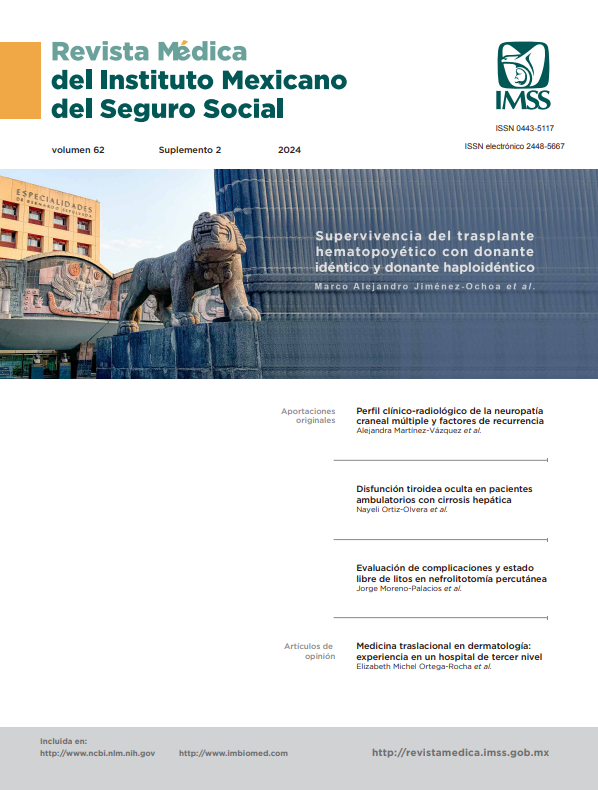Survival after hematopoietic stem cell transplantation with identical and haploidentical donors
Main Article Content
Keywords
Bone Marrow, Survival, Transplantation
Abstract
Background: Allogeneic hematopoietic stem cell transplantation (HSCT) is a therapy that offers the potential to cure hematological malignancies. One limitation is that only 25% of patients will have an identical donor. The use of haploidentical donors allows 95% of patients to have a donor. Experience in Mexico with haploidentical HSCT is limited. In 2018, the Haploidentical Transplantation Program began at the Hospital de Especialidades (Specialties Hospital) from the Centro Médico Nacional Siglo XXI (21st Century National Medical Center).
Objective: To compare the overall survival of patients undergoing HSCT with an identical or haploidentical donor at the Hospital de Especialidades.
Material and methods: A retrospective, observational study was carried out in patients undergoing HSCT at the Hospital de Especialidades, from January 2018 to December 2022. All patients who received HSCT were included. Overall survival analysis was performed using Kaplan-Meier curves. A significance level of p < 0.05 was considered.
Results: 109 patients who underwent to allogeneic HSCT were analyzed, 34% of them had a haploidentical donor. There were no differences in overall survival. The haploidentical group presented greater cytomegalovirus reactivation and less chronic graft-versus-host disease (GVHD).
Conclusions: No differences in survival were found in both groups, which is why haploidentical transplantation could be a good treatment option in patients who do not have an identical donor at our institution.
References
Kaleka G, Schiller G. Immunotherapy for Acute Myeloid Leukemia: Allogeneic hematopoietic cell transplantation is here to stay. Leuk Res. 2022;112:106732. doi:10.1016/j.leukres.2021.106732
Rafiee M, Abbasi M, Rafieemehr H, et al. A concise review on factors influencing the hematopoietic stem cell transplantation main outcomes. Health Sci Rep. 2021 May 7;4(2):e282. doi: 10.1002/hsr2.282.
Greer JP, Wintrobe MM, Gilleece MH. Hematopoietic Cell Transplantation for Hematologic Malignancies. In: Wintrobe's clinical hematology. 14th ed. Philadelphia, Philadelphia: Lippincott Williams & Wilkins; 2019. p. 6821–40.
Dekker L, Sanders E, Lindemans CA, et al. Naive T Cells in Graft Versus Host Disease and Graft Versus Leukemia: Innocent or Guilty? Front Immunol. 2022 Jun 20;13:893545. doi: 10.3389/fimmu.2022.893545
Ab Rahman S, Matic T, Yordanova M, Ariffin H. HLA-Haploidentical Family Donors: The New Promise for Childhood Acute Lymphoblastic Leukaemia? Front Pediatr. 2022 Jan 21;9:758680. doi: 10.3389/fped.2021.758680.
Mangum DS, Caywood E. A clinician's guide to HLA matching in allogeneic hematopoietic stem cell transplant. Hum Immunol. 2022 Oct;83(10):687-694. doi: 10.1016/j.humimm.2022.03.002.
Grifoni A, Moore E, Voic H, et al. Characterization of Magnitude and Antigen Specificity of HLA-DP, DQ, and DRB3/4/5 Restricted DENV-Specific CD4+ T Cell Responses. Front Immunol. 2019 Jul 5;10:1568. doi: 10.3389/fimmu.2019.01568.
Little AM, Akbarzad-Yousefi A, Anand A, et al. BSHI guideline: HLA matching and donor selection for haematopoietic progenitor cell transplantation. Int J Immunogenet. 2021 Apr;48(2):75-109. doi: 10.1111/iji.12527.
Calvo C, Ronceray L, Dhédin N, et al. Haematopoietic Stem Cell Transplantation in Adolescents and Young Adults With Acute Lymphoblastic Leukaemia: Special Considerations and Challenges. Front Pediatr. 2022 Jan 11;9:796426. doi: 10.3389/fped.2021.796426
Socié G, Stone JV, Wingard JR, et al. Long-term survival and late deaths after allogeneic bone marrow transplantation. Late Effects Working Committee of the International Bone Marrow Transplant Registry. N Engl J Med. 1999 Jul 1;341(1):14-21. doi: 10.1056/NEJM199907013410103.
Ringdén O, Labopin M, Ciceri F, et al. Is there a stronger graft-versus-leukemia effect using HLA-haploidentical donors compared with HLA-identical siblings? Leukemia. 2015;30(2):447–55. doi: 10.1038/leu.2015.232.
Lv M, Chang YJ, Huang XJ. Update of the "Beijing Protocol" haplo-identical hematopoietic stem cell transplantation. Bone Marrow Transplant. 2019 Aug;54(Suppl 2):703-707. doi: 10.1038/s41409-019-0605-2
Martin PJ, Counts GW Jr, Appelbaum FR, et al. Life expectancy in patients surviving more than 5 years after hematopoietic cell transplantation. J Clin Oncol. 2010 Feb 20;28(6):1011-6. doi: 10.1200/JCO.2009.25.6693.
Wang Y, Liu QF, Xu LP, et al. Haploidentical vs identical-sibling transplant for AML in remission: a multicenter, prospective study. Blood. 2015 Jun 18;125(25):3956-62. doi: 10.1182/blood-2015-02-627786.
Majhail NS, Bajorunaite R, Lazarus HM, et al. High probability of long-term survival in 2-year survivors of autologous hematopoietic cell transplantation for AML in first or second CR. Bone Marrow Transplant. 2011 Mar;46(3):385-92. doi: 10.1038/bmt.2010.115.
Yan CH, Xu LP, Wang FR, et al. Causes of mortality after haploidentical hematopoietic stem cell transplantation and the comparison with HLA-identical sibling hematopoietic stem cell transplantation. Bone Marrow Transplant. 2016 Mar;51(3):391-7. doi: 10.1038/bmt.2015.306.
McCurdy SR, Luznik L. How we perform haploidentical stem cell transplantation with posttransplant cyclophosphamide. Blood. 2019 Nov 21;134(21):1802-1810. doi: 10.1182/blood.2019001323.
Fabricius WA, Ramanathan M. Review on Haploidentical Hematopoietic Cell Transplantation in Patients with Hematologic Malignancies. Adv Hematol. 2016;2016:5726132. doi: 10.1155/2016/5726132
Spierings E, Fleischhauer K. Histocompatibility. In: The EBMT Handbook. Switzerland: Springer; 2019. p. 93–100.
Trucco JI, Berro M, Basquiera AL. et al. Comparación de donantes relacionados, no relacionados y haploidénticos en trasplante de progenitores hematopoyéticos. Experiencia del Grupo Argentino de Trasplante de Médula Ósea y Terapia Celular (GATMO-TC). Medicina (Buenos Aires) 2020; 80: 654-662.
Meybodi MA, Cao W, Luznik L, et al. HLA-haploidentical vs matched-sibling hematopoietic cell transplantation: a systematic review and meta-analysis. Blood Adv. 2019;10;3(17):2581-2585. doi: 10.1182/bloodadvances.2019000614.
McCurdy SR, Kasamon YL, Kanakry CG, et al. Comparable composite endpoints after HLA-matched and HLA-haploidentical transplantation with post-transplantation cyclophosphamide. Haematologica. 2017 Feb;102(2):391-400. doi: 10.3324/haematol.2016.144139.
Pond GR, Lipton JH, Messner HA. Long-term survival after blood and marrow transplantation: comparison with an age- and gender-matched normative population. Biol Blood Marrow Transplant. 2006;12(4):422-429. doi:10.1016/j.bbmt.2005.11.518
Morales Polanco MR, Pizzuto Chavez J. Trasplante de medula osea en anemia aplastica. Estado actual y revisión de los primeros trasplantes alogenéicos en Mexico. Gac Med Mex. 1984;120(2):49-57. Disponible en: https://www.anmm.org.mx/bgmm/1864_2007/1984%20v120%20n2%20%5B49-57%5Dpdf
Ruggeri A, Labopin M, Angelucci E, et al. Prognostic factors for neutrophil engraftment after haploidentical cell transplantation with PT-Cy in patients with acute myeloid leukemia in complete remission, on behalf of the ALWP-EBMT. Bone Marrow Transplant. 2021;56(8):1842-1849. doi: 10.1038/s41409-021-01248-3.
Bolaños-Meade J, Hamadani M, Wu J. Post-Transplantation Cyclophosphamide-Based Graft-versus-Host Disease Prophylaxis. N Engl J Med. 2023;388(25):2338-2348. doi:10.1056/NEJMoa2215943


